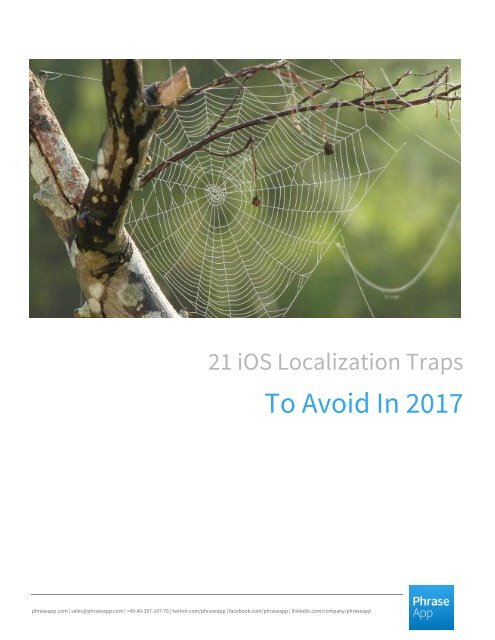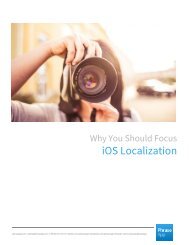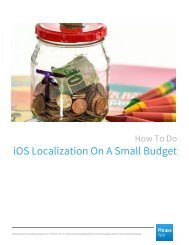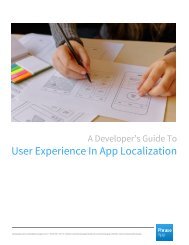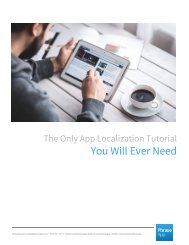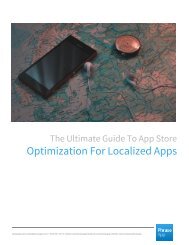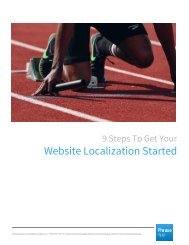21IOSLocalizationTrapsToAvoidIn2017
Create successful ePaper yourself
Turn your PDF publications into a flip-book with our unique Google optimized e-Paper software.
21 iOS Localization Traps<br />
To Avoid In 2017<br />
phraseapp.com | sales@phraseapp.com | +49-40-357-187-76 | twitter.com/phraseapp | facebook.com/phraseapp | linkedin.com/company/phraseapp
21 iOS Localization Traps To Avoid In 2017<br />
Table of Content<br />
Why IOS Localization? 4<br />
1. Creating Your IOS App Without Thinking About Localization 5<br />
2. Not Translating Your App’s Name When Needed 5<br />
3. Using The Same Icon For All Audiences 6<br />
4. Designing Your App For One Language Only 7<br />
5. Postponing IOS Localization 8<br />
6. Organizing Separate Teams Within The Project 8<br />
7. Starting Without A Localization Manager 9<br />
8. Not Targeting Audiences In Each Country Before Starting 9<br />
9. Using Free Translation Sources To Save Money 10<br />
10. Not Providing Your Translators With The Right Context 11<br />
11. Working Without Clear Goals And Deadlines 11<br />
12. Not Using Translation Management Software 12<br />
13. Targeting Languages, Instead Of Countries 12<br />
14. Ignoring Cultural Factors 13<br />
15. Skipping Marketing Localization 14<br />
16. Underestimating Your Competitors 14<br />
17. Not Translating Everything 15<br />
18. Not Working With A Local Team 15<br />
19. Using The Same Content For All Countries Instead Of Encouraging Local Contributors 16<br />
20. Not Evaluating All Costs Before Starting 17<br />
21. Launching Your App Without Testing It 17<br />
phraseapp.com | sales@phraseapp.com | +49-40-357-187-76 | twitter.com/phraseapp | facebook.com/phraseapp | linkedin.com/company/phraseapp
21 iOS Localization Traps To Avoid In 2017<br />
iOS localization is becoming more important as the number of iPhone subscribers grows. If you<br />
want your project to run smoothly, check out these 21 iOS localization traps to avoid in 2017.<br />
If you want to make your iOS app more visible and reach new customers this year, you’ll have<br />
to step out of your comfort zone. How do you do that? By localizing your app and seeking new<br />
customers in different parts of the world. Mobile apps have become global and, by 2020,<br />
revenues could exceed $101 billion. If you want a piece of the action in 2017, you’ll need to<br />
move fast. Plan for iOS localization that is both universal and local, for every new market you<br />
approach.<br />
Why IOS Localization?<br />
The close of 2016 bought some pretty good news for Apple. Despite fierce competition, iOS<br />
operating systems still make for the most desirable smartphone in the world. Sales of iPhone 7<br />
reached respectable numbers in almost all countries. So, from China to India, Mexico to<br />
Thailand, your next customer could come from anywhere! Get your iOS localization strategy<br />
right and your downloads will grow faster than ever.<br />
Just take a look at the App Store and you’ll see that iOS app localization is no longer a strategy<br />
to ignore. The most popular apps, including Facebook, WhatsApp, Netflix and Uber, are all<br />
localized. With iOS 10’s latest update, localizing your iOS app is now easier than ever before. So,<br />
if you haven’t started to prepare your iOS localization process yet, this should be your top<br />
priority in 2017.<br />
But, as with so much in life, there’s a right way and a wrong way of localizing your iOS app. You<br />
need to have a clear view on the process, so that you can reach as many customers in their<br />
native languages as possible. It’s not just about translating your content and adding a nice flag<br />
on your icon. You need to get ready to reinvent yourself every time you enter a new market!<br />
The best way of doing this is by avoiding those localization traps that make you spend time and<br />
money, without yielding results. To get you started, here are 21 iOS localization traps to avoid<br />
in 2017.<br />
phraseapp.com | sales@phraseapp.com | +49-40-357-187-76 | twitter.com/phraseapp | facebook.com/phraseapp | linkedin.com/company/phraseapp
21 iOS Localization Traps To Avoid In 2017<br />
1. Creating Your IOS App Without Thinking About<br />
Localization<br />
Correct iOS localization means creating a product that’s ready to go global right from the start.<br />
When you factor in international expansion from the beginning, rolling out multiple language<br />
versions will be much easier. This process is called internationalization. You are basically<br />
ensuring that your app is flexible enough to be tailored to any local market. You can stretch the<br />
design, change the colors and rewrite the code with ease.<br />
In other words, you should write your app so that it’s easy to translate, even though this will<br />
add some initial expense. Separate your text from your code and make sure your programmers<br />
use Unicode strings. This is the easiest way to develop an iOS app that can support any<br />
language and character. You may not know from the beginning which countries you’re going to<br />
target in the future. So, by leaving an open door to modifications, you’ll save time and money<br />
when you start the iOS localization processes.<br />
2. Not Translating Your App’s Name When Needed<br />
In most cases, it doesn’t matter how cool or interesting a name sounds in English when you<br />
take it global. If it isn’t appealing enough for foreigners, there’s no chance your app’s name will<br />
sell outside your country.<br />
Your app’s name should be easy to pronounce and recognize. Keeping it short and using clear<br />
descriptions of your app is essential. Especially when your products are sold in stores with over<br />
2 million other apps waiting in line! With so many options, customers simply won’t take the<br />
time to understand the meaning behind a strange sounding name. They’ll just download<br />
something else.<br />
Translating your app’s name is a wise solution, as long as you can keep your brand identity<br />
intact. Make sure that the translated meaning is close to your original name, as there’s nothing<br />
more frustrating than a misleading app name! The price for this kind of mistake during iOS<br />
localization is bad reviews. What do bad reviews lead to? Poor ranking in the App Store.<br />
phraseapp.com | sales@phraseapp.com | +49-40-357-187-76 | twitter.com/phraseapp | facebook.com/phraseapp | linkedin.com/company/phraseapp
21 iOS Localization Traps To Avoid In 2017<br />
Before you start to panic, changing a brand’s name isn’t uncommon. Even large companies do<br />
it when they switch languages. LinkedIn did it for the Chinese version of their platform, with<br />
excellent results. As long as you spend the time to research each individual market, you should<br />
be able to come up with a name that will suit their tastes.<br />
3. Using The Same Icon For All Audiences<br />
The average person is exposed to more than 5,000 brand messages and ads every day. Which is<br />
an awful lot of competing traffic! How many of these ads and commercial messages get<br />
noticed? Around 12. That’s right! 12! With such a miniscule chance for brand visibility, the need<br />
to create a strong icon for your iOS app that leaves an impact is higher than ever.<br />
When it comes to iOS localization, your app’s icon plays an important role. People tend to press<br />
the download button when they’re charmed by an inviting image, regardless of where they<br />
come from. But, keeping the same visual for all markets is risky. Why? Because colors and<br />
symbols have different meanings from one country to another.<br />
Of course, any change you make requires significant research and testing. You need to keep<br />
your unique identity while still respecting local cultures. Coca Cola had to rethink its logo to sell<br />
in China, as the traditional one held no meaning for the locals. Despite translation and use of<br />
different symbols, the global manufacturing giant managed to maintain its distinctive features.<br />
You may not have the same kind of budget as Coca Cola, but you can still come up with a<br />
flexible plan. Choose an icon without text that uses no religious symbols of any kind. This will<br />
save you a lot of trouble when it comes to approaching new audiences.<br />
phraseapp.com | sales@phraseapp.com | +49-40-357-187-76 | twitter.com/phraseapp | facebook.com/phraseapp | linkedin.com/company/phraseapp
21 iOS Localization Traps To Avoid In 2017<br />
4. Designing Your App For One Language Only<br />
Your layout may look great in the original version of your app. But you need to consider how it<br />
will look when it’s translated to Arabic, French, or Spanish. China has become an important<br />
market for iOS apps. So, it’s time to think seriously about creating an appealing design to sell in<br />
countries where iOS is particularly popular.<br />
Many languages need more space than English for saying the same thing, as they have different<br />
grammar structures and phrases. So, don’t let a nice layout mislead you if it isn’t malleable<br />
enough to accommodate foreign text. Keep it practical, or you’ll spend long hours trying to<br />
make difficult words and expressions fit the constraints of your original design.<br />
phraseapp.com | sales@phraseapp.com | +49-40-357-187-76 | twitter.com/phraseapp | facebook.com/phraseapp | linkedin.com/company/phraseapp
21 iOS Localization Traps To Avoid In 2017<br />
5. Postponing IOS Localization<br />
Even if you’re keeping localization in mind from day one, that doesn’t mean much if you’re not<br />
doing anything about it. So, make it your resolution to take action in 2017. There’s no better<br />
time to start than right now. Every day you delay localizing your app gives the competition<br />
more and more opportunity to beat you to the market.<br />
Waiting for important updates, or over-thinking the process are really just excuses. All updates<br />
and improvements can still be carried out during the iOS localization process. After all, when<br />
you plan for localization from the outset, it’s the easiest way to avoid mistakes.<br />
6. Organizing Separate Teams Within The Project<br />
App localization can take weeks, or even months, depending on how fast you move and how<br />
willing you are to get involved in the process. Localization is harder if your team doesn’t<br />
understand each aspect of your project. You don’t need your translators to be programmers, or<br />
your developers to speak several tongues. But, they do need a clear understanding of the role<br />
of every person on the team.<br />
Translators often don’t possess much technical knowledge, while programmers usually aren’t<br />
aware of cultural differences. Hiring a marketing specialist is a good idea, but you’ll need to use<br />
local resources for each market to correctly gauge the audience and new ways of thinking. And<br />
you need all these people to come together, if you want things to move smoothly.<br />
Localization requires a lot of teamwork, so be sure to involve all departments. It’s almost like<br />
launching your app from scratch, except that you’re doing it for a different audience. And that<br />
makes things harder, not easier.<br />
phraseapp.com | sales@phraseapp.com | +49-40-357-187-76 | twitter.com/phraseapp | facebook.com/phraseapp | linkedin.com/company/phraseapp
21 iOS Localization Traps To Avoid In 2017<br />
7. Starting Without A Localization Manager<br />
Coordinating your localization team is a full-time job. So, if you’re already overloaded with<br />
work, you should find someone to oversee the process for you. A good localization manager will<br />
work closely with your translators, programmers and engineers. They’ll have a complete view<br />
of the project and know how to manage time, budget and resources efficiently. This will free<br />
you up to focus on steering your business forward, while remaining in contact with your iOS<br />
localization team.<br />
8. Not Targeting Audiences In Each Country Before<br />
Starting<br />
Just as you conducted research before launching your iOS app in your country, you’ll need to<br />
identify your international buyer personas as well. Find out about potential customers in every<br />
new country you intend to launch your app.<br />
What you know about your national audience counts for very little when you go global.<br />
Foreigners have different mindsets and buying habits, ideologies and preferences. So, if you<br />
want to make them download your app, learn to speak their language like a native.<br />
Correctly targeting audiences is essential for successful app localization. This way, you can<br />
send relevant messages to your customers and be sure of higher engagement. If users can<br />
easily identify themselves with your product, you’ll increase downloads and positive reviews.<br />
This will increase your ranking in local App Stores and generate higher revenue.<br />
phraseapp.com | sales@phraseapp.com | +49-40-357-187-76 | twitter.com/phraseapp | facebook.com/phraseapp | linkedin.com/company/phraseapp
21 iOS Localization Traps To Avoid In 2017<br />
9. Using Free Translation Sources To Save Money<br />
Many small business owners make this mistake, thinking that they can reduce costs. But most<br />
of them end up spending more money fixing problems that could have been avoided in the first<br />
place.<br />
In 2017, human translation is the only way you can guarantee you’re sending the right message<br />
to your clients. Machines can rewrite what you say in any language. But, they lack the ability of<br />
keeping the meaning you wish to give to each phrase. In other words, translate by robots and<br />
you’ll end up with text that sounds like it was translated by robots.<br />
Your long-studied marketing strategy will amount to nothing if your app’s name and<br />
description, or CTA buttons sound odd – or worse – offensive!<br />
phraseapp.com | sales@phraseapp.com | +49-40-357-187-76 | twitter.com/phraseapp | facebook.com/phraseapp | linkedin.com/company/phraseapp
21 iOS Localization Traps To Avoid In 2017<br />
10. Not Providing Your Translators With The Right<br />
Context<br />
Working with translators means you’ll have real people choosing the most appropriate words<br />
to use depending on each context. So, you’ll need to give them all the details about your app.<br />
Just sending them some texts or strings to translate, without explaining what they’re writing<br />
about will create confusion. You’ll end up with a lot of back and forth, making things harder to<br />
manage for everyone involved in the localization process.<br />
Translators don’t just convert texts from one language to another. A professional team<br />
understands cultural differences, knows about jargon and colloquial phrases, and when to use<br />
them to make a difference. They can help you reshape your message to make it sell your<br />
product better.<br />
Many translators who provide app localization services are used to working with strings and<br />
software. So, by giving them all the information they need, you’ll get the best results possible.<br />
This includes uploading screen shots, notes and suggestions, as well as providing them with a<br />
list of keywords for your ASO goals.<br />
11. Working Without Clear Goals And Deadlines<br />
Even though app localization is a complex process, you should separate the steps and keep<br />
track of your progress. If you don’t set clear goals and just wait for everything to be done before<br />
evaluating, you risk wasting time and spending extra money.<br />
By allowing your team to work without intermediary milestones, you risk losing control over<br />
the process and will delay the launch of your localized iOS app. So, create a localization<br />
calendar to follow. This way, you can measure your team’s work while keeping an eye on costs<br />
and deadlines.<br />
phraseapp.com | sales@phraseapp.com | +49-40-357-187-76 | twitter.com/phraseapp | facebook.com/phraseapp | linkedin.com/company/phraseapp
21 iOS Localization Traps To Avoid In 2017<br />
12. Not Using Translation Management Software<br />
If this is your first iOS localization endeavor, you may not know what translation management<br />
software is. But that doesn’t make it any less important for your team. By using the right<br />
translation management software, you can work efficiently and harmoniously.<br />
No more long email threads and communication errors. Everything they need to know is one<br />
click away and they can work easier and faster. The can collaborate on one platform, and even<br />
over different time zones. Developers can upload context for translators. Translators can leave<br />
explanations. And your localization manager can glean the progress of your iOS localization<br />
project with one simple glance.<br />
13. Targeting Languages, Instead Of Countries<br />
You’ve translated your iOS app into Spanish and now you feel ready to conquer all of South<br />
America. Slow down! Sorry to say this, but that’s the wrong way of going about iOS localization.<br />
Each country is different, so keep that in mind when localizing your app. Mexicans use different<br />
vocabulary from Argentinians. Customers who live in Costa Rica don’t share the same climate<br />
as those in Europe.<br />
Just think about the English language. If you’ve ever shared a conversation with an Irishman,<br />
South African, or Australian, you’ll know that even when speaking the same language, there’s a<br />
lot of scope for misunderstandings!<br />
phraseapp.com | sales@phraseapp.com | +49-40-357-187-76 | twitter.com/phraseapp | facebook.com/phraseapp | linkedin.com/company/phraseapp
21 iOS Localization Traps To Avoid In 2017<br />
14. Ignoring Cultural Factors<br />
Our vision of the world is made up of clichés. The French love garlic. The Spanish dance<br />
Flamenco. Argentinians can’t get enough of eating beef. While there may be some semblance of<br />
truth about some of these beliefs, most of what we know about specific countries is actually<br />
untrue. Assuming that you know about a culture because you watched a television program<br />
about it isn’t going to cut it.<br />
You’ll need to go deeper into the local market to give your customers a positive user<br />
experience. Adapt your content to the cultural differences in each country to become<br />
successful in local markets. Humor, relationships, etiquette and societal values vary from one<br />
region to another. Ignoring these essential differences will almost certainly transform your<br />
investment into failure.<br />
phraseapp.com | sales@phraseapp.com | +49-40-357-187-76 | twitter.com/phraseapp | facebook.com/phraseapp | linkedin.com/company/phraseapp
21 iOS Localization Traps To Avoid In 2017<br />
15. Skipping Marketing Localization<br />
Knowing the local market will be a necessary advantage when you launch your app in a new<br />
country. iOS localization should involve a marketing expert from day one, to make sure you<br />
invest in the right modifications. Translating keywords is better than no strategy at all, but that<br />
alone isn’t going to boost your downloads.<br />
You’ll need to see what works in each specific country and optimize your content for each local<br />
market. Come up with a flexible ASO strategy, with new descriptions and meta data that work<br />
for each individual market and local media.<br />
There are hundreds of new iOS apps in the App Store every day. So, you’ll need to get yours<br />
right if you want to get noticed and increase downloads and sales.<br />
16. Underestimating Your Competitors<br />
2017 is set to take app localization to the next level. Even the smallest developers will localize<br />
their apps to increase their revenues. And they’ll find new ways of making themselves known<br />
globally. Your competitors are going to be everywhere, so you’ll need to step up to the plate.<br />
You’ll also have to deal with local iOS app developers, who have the advantage of knowing the<br />
local market better than you do. So, don’t ignore the competition. Don’t put together a strategy<br />
as if you were the only player on the market. Learn as much as possible from your competitors<br />
so that you can become better than them.<br />
Make sure your team knows all about different local app stores. What apps are popular, why<br />
people download them, how many positive reviews there are and what features generated<br />
them. Use all these insights to improve your product and marketing strategy, to get more 4 and<br />
5 stars reviews and increase your position in the App Store.<br />
phraseapp.com | sales@phraseapp.com | +49-40-357-187-76 | twitter.com/phraseapp | facebook.com/phraseapp | linkedin.com/company/phraseapp
21 iOS Localization Traps To Avoid In 2017<br />
17. Not Translating Everything<br />
You’ve probably already realized by now that app localization means more than translating<br />
names, descriptions and screenshots. You need to translate and localize everything for your<br />
audience. Customers will feel tricked if they download an iOS app with an enticing description<br />
they completely understand, only to receive a download that’s only half translated.<br />
You may save money and time by not translating all maps, error messages or feedback<br />
requests. But this will soon come back to you like a boomerang, with negative reviews and<br />
unsatisfied users. Don’t forget that almost 90% of apps are deleted as fast as they’re<br />
downloaded. If yours doesn’t live up to expectations, it will be wiped out of your user’s memory<br />
in instants.<br />
18. Not Working With A Local Team<br />
No matter how effective your localization team is, you’ll need a “local touch” to obtain useful<br />
feedback. Local experts can easily identify any unnatural sounding words you’ve used during<br />
translation. They can also provide you with important advice about how to approach your<br />
audience.<br />
Another great advantage when working with locals comes from the fact that you get an<br />
accurate idea about legislation. It’s hard to keep track of all legal modifications, especially in<br />
countries where new laws don’t make the international news. A local team will always know<br />
what’s new in the field and keep you away from unwanted legal issues.<br />
phraseapp.com | sales@phraseapp.com | +49-40-357-187-76 | twitter.com/phraseapp | facebook.com/phraseapp | linkedin.com/company/phraseapp
21 iOS Localization Traps To Avoid In 2017<br />
19. Using The Same Content For All Countries Instead<br />
Of Encouraging Local Contributors<br />
When you promote your iOS app, you’ll need content outside of your app. That includes a<br />
website and a consistent presence on popular social media channels. You’ll need to customize<br />
your content across each different region if you want your brand to resonate in local markets.<br />
So, work with transcreation professionals or local writers who can craft an appealing message,<br />
rather than a translated one. This is particularly useful when considering seasonal promotions<br />
or local public holidays. This will help you obtain higher engagement from your audience. The<br />
key is to maintaining a consistent message in keeping with your brand identity.<br />
phraseapp.com | sales@phraseapp.com | +49-40-357-187-76 | twitter.com/phraseapp | facebook.com/phraseapp | linkedin.com/company/phraseapp
21 iOS Localization Traps To Avoid In 2017<br />
20. Not Evaluating All Costs Before Starting<br />
Localization isn’t cheap. So, when starting your iOS localization project, make sure you include<br />
all expenses, not just what you’ll pay for translators. You’ll need programmers, a local team,<br />
testers, and a marketing campaign to promote your app in the new market.<br />
Set a clear cost structure from the beginning. This way, you can calculate a budget and,<br />
depending on your resources, decide on the dimensions of your iOS localization project.<br />
21. Launching Your App Without Testing It<br />
Testing may mean additional costs. If you’re working on a low budget and already missing a<br />
deadline, you may feel tempted to skip testing. But hoping that all translations and technical<br />
details match your standards (and your customers’) isn’t a good idea.<br />
Getting feedback before the actual launch is essential, as there’s no second chance to make a<br />
first impression. All your hard work will be in vain if your foreign users download an app that<br />
fails to meet their expectations. So, test everything, from texts and customer care, to<br />
compatibility with all Apple mobile devices. Fix any problems that appear before your app<br />
comes out.<br />
iOS localization is not as complicated as it looks. With the right team and the right tools, you<br />
can conquer global markets. The most important thing is to spend less time thinking about it<br />
and more time acting on it. Every day you fail to start your iOS localization strategy means<br />
more money that will go into someone else’s pockets.<br />
phraseapp.com | sales@phraseapp.com | +49-40-357-187-76 | twitter.com/phraseapp | facebook.com/phraseapp | linkedin.com/company/phraseapp
21 iOS Localization Traps To Avoid In 2017<br />
phraseapp.com<br />
sales@phraseapp.com<br />
+49-40-357-187-76<br />
Große Theaterstraße 39<br />
Hamburg, Germany<br />
phraseapp.com | sales@phraseapp.com | +49-40-357-187-76 | twitter.com/phraseapp | facebook.com/phraseapp | linkedin.com/company/phraseapp


